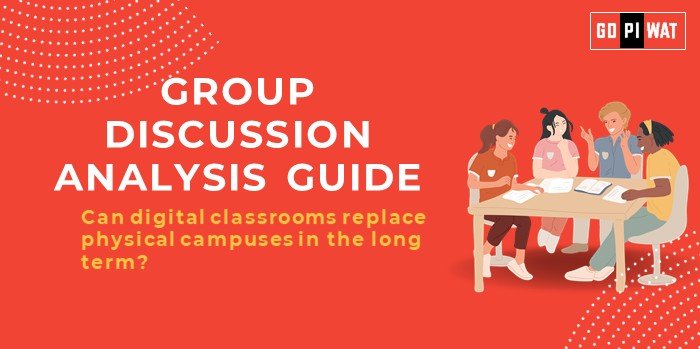📋 Group Discussion (GD) Analysis Guide: Can Digital Classrooms Replace Physical Campuses in the Long Term?
🌐 Introduction
- 📍 Opening Context: As education embraces technology, digital classrooms have gained prominence, especially after the global pivot during the COVID-19 pandemic. This raises a critical question: Can digital classrooms completely replace physical campuses in the future?
- 📜 Background: Digital learning surged in the past decade with advancements in internet access, e-learning platforms, and virtual reality tools. However, the efficacy and long-term impact of replacing physical campuses with digital alternatives remain contested.
📊 Quick Facts and Key Statistics
- 🌍 Global EdTech Market Size: $254.8 billion in 2022, projected to grow at a CAGR of 13.6% by 2030 (Source: Allied Market Research).
- 🌐 Internet Access in Education: Over 40% of students globally lack reliable internet, according to UNICEF (2023).
- 📈 Online Learning Adoption: 84% of educators in the U.S. use some form of digital platform.
- 📉 Dropout Rates: E-learning courses report 40-60% dropout rates, significantly higher than physical classrooms.
🤝 Stakeholders and Their Roles
- 🏫 Educational Institutions: Transitioning to hybrid or fully digital models.
- 💻 EdTech Companies: Driving innovation in digital tools and AI-driven learning platforms.
- 👨🎓 Students and Parents: Adapting to changing learning modalities while navigating challenges like the digital divide and self-discipline.
- 🏛️ Governments: Supporting digital infrastructure and policies to ensure equitable access to education.
🏆 Achievements and Challenges
🌟 Achievements
- 🌍 Scalability: Platforms like Coursera and BYJU’S provide access to millions globally.
- 💰 Cost-Effectiveness: Digital classrooms reduce operational costs for institutions and students.
- 🤖 Technological Integration: VR and AI tools enhance interactive and immersive learning experiences.
- ⏳ Flexibility: Allows personalized learning schedules and access from remote locations.
⚠️ Challenges
- 🌐 Digital Divide: Limited internet and device access in rural and underserved areas.
- 💢 Effectiveness Gap: Lack of hands-on learning, professional networking, and campus culture.
- 🧠 Mental Health Concerns: Increased screen time and isolation impacting student well-being.
- 👩🏫 Teacher Training: Many educators lack the skills to effectively utilize digital tools.
🌍 Global Comparisons
- ✅ Success: Estonia leads in digital education integration with strong government support.
- ❌ Challenges: The U.S. faces issues with digital fatigue among students.
📖 Case Study
🌟 Kerala, India: Achieved 90% digital penetration in schools, but persistent gaps remain in rural and underserved regions.
💬 Structured Arguments for Discussion
✅ Supporting Stance
“Digital classrooms democratize education, making it accessible to millions globally, bridging traditional geographic and economic barriers.”
❌ Opposing Stance
“The lack of interpersonal interactions and experiential learning in digital classrooms limits holistic development.”
⚖️ Balanced Perspective
“Digital and physical classrooms should coexist, leveraging technology for accessibility while preserving the benefits of in-person interaction.”
🚀 Effective Discussion Approaches
🔑 Opening Approaches
- 🔀 Contrast: “While digital classrooms offer scalability, their limited engagement compared to physical campuses is a challenge.”
- 📊 Statistics: “With the global EdTech market at $254 billion, digital learning’s potential is undeniable.”
🤝 Counter-Argument Handling
- 📉 Acknowledge limitations: “The digital divide and effectiveness gaps are real concerns, especially in underserved regions.”
- 🔧 Hybrid Models: Highlight solutions like blended learning models that combine the strengths of both digital and physical classrooms.
🔍 Strategic Analysis (SWOT)
- 💪 Strengths: Scalability, cost-efficiency, and global access.
- ⚠️ Weaknesses: Digital fatigue, high dropout rates, and lack of networking.
- ✨ Opportunities: Integration with AI/VR, global partnerships, and skill-based digital learning.
- 🚧 Threats: Cybersecurity risks and a widening digital divide in marginalized regions.
🎓 Connecting with B-School Applications
- 🌐 Real-World Applications: Scaling hybrid learning models and exploring innovations in EdTech platforms.
- 💬 Sample Interview Questions:
- 💡 “How can digital classrooms be integrated into traditional B-school programs?”
- 💡 “What role can EdTech play in achieving global education equity?”
- 🚀 Insights for B-School Students:
- 📊 Understand digital transformation insights for operational and strategy roles.
- ✨ Explore research opportunities on balancing technology and human interaction in education.
📄 Source: Compiled Analysis, 2024


